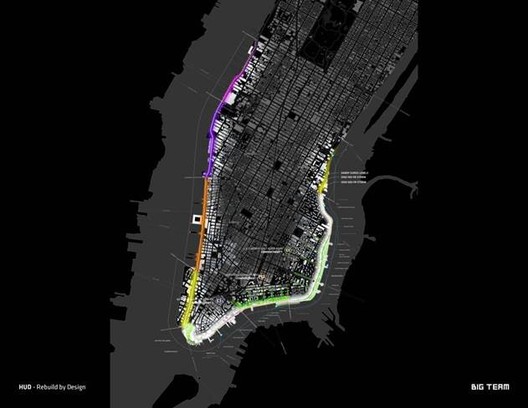The Big

Yesterday BIG, forth with 9 other teams including OMA and WXY, unveiled their proposals for "Rebuild by Pattern," a competition which tasks teams with improving the resiliency of waterfront communities through locally-responsive, innovative design. Each proposal was required to exist "flexible, hands phased, and able to integrate with existing projects in progress." Equally Henk Ovink, the Primary of "Rebuild by Design" too equally the Senior Counselor to the U.South. Department of Housing and Urban Evolution (HUD) Secretary Shaun Donovan, stated: "Rebuild past Design is not nearly making a plan, but well-nigh changing a culture." The winners will be announced later this spring.
Large's proposal, The Big U, is rooted in the firm's signature concepts of social infrastructure and hedonistic sustainability. Information technology envisions a 10-mile protective system that encircles Manhattan, protecting the urban center from floods and tempest water while simultaneously providing public realms specific to the needs of the city's diverse communities. Bjarke Ingels states: "We asked ourselves: What if nosotros could envision the resilience infrastructure for Lower Manhattan in a fashion that wouldn't be like a wall betwixt the city and the water, but rather a cord of pearls of social and environmental amenities tailored to their specific neighborhoods, that likewise happens to shield their various communities from flooding. Social infrastructure understood every bit a big overall strategy rooted in the local communities."
More on the Big U, later on the pause...

From Large.The Large U is a protective system that encircles Manhattan, responding to the needs and concerns of the island'south various communities. Stretching from W 57th Street south to The Battery and upward to East 42nd Street, the Large U protects 10 continuous miles of low-lying geography that comprise an incredibly dense, vibrant, and vulnerable urban area. The team's approach is rooted in the two concepts of social infrastructure and hedonistic sustainability. The Big U not only shields the city against floods and tempest water; it provides social and environmental benefits to the community, and fosters an improved public realm. The team envisions three compartments that function independently to provide flood protection. Each compartment comprises a physically detached flood-protection zone that can be isolated from flooding in next zones. At the aforementioned time, each presents opportunities for integrated social and community planning. The compartments work in unison to protect and enhance the city, however each compartment's proposal is designed to stand on its own.

The proposal consists of divide but coordinated plans for three contiguous regions of the waterfront and associated communities, regions dubbed compartments. Each compartment comprises a physically separate overflowing-protection zone, isolated from flooding in the other zones, just each as a field for integrated social and customs planning. The compartments work in concert to protect and heighten the metropolis, but each compartment's proposal is designed to stand on its own. Each compartment was designed in close consultation with the associated communities and many local, municipal, land and federal stakeholders; each has a do good-price ratio greater than i; and each is flexible, easily phasable, and tin can be integrated with in-progress developments along the Metropolis's waterfront.

Bridging Berm provides robust vertical protection for the Lower Due east Side from future storm surge and ascension sea levels. The Berm also offers pleasant, accessible routes into the park, with many unprogrammed spots for resting, socializing, and enjoying views of the park and river. Both berms and bridges are wide and planted with a diverse selection of table salt tolerant trees, shrubs and perennials, providing a resilient urban habitat.

Betwixt the Manhattan Bridge and Montgomery Street, deployable walls are attached to the underside of the FDR Bulldoze, ready to flip down to set up for flood events. Decorated by neighborhood artists, the panels when not in use create an inviting ceiling above the East River Esplanade. At night, lighting integrated into the panels transforms a currently menacing area into a safe destination. Panels tin can as well exist flipped down to protect from the elements, creating a seasonal market place during the winter.
The due east and west boundaries of the Bombardment were fundamental inlets during Hurricane Sandy, allowing floodwaters to blitz into Lower Manhattan and shut downwards the nation'southward – and the world's – premier fiscal district. Enhancing the public realm while protecting the Fiscal District and critical transportation infrastructure beyond, the Bombardment Berm weaves an elevated path through the park. Along this berm, a series of upland knolls grade unique landscapes where people farm, sunbathe, eat and engage with world class gardens.

In place of the existing Coast Guard building, the plan envisions a new edifice programmed as a maritime museum or environmental education facility, whose form is derived from the flood protection at the water-facing ground floor. This signature edifice features a "Reverse Aquarium" which enables visitors to observe tidal variations and sea level rise while providing a alluvion bulwark.

The Big Squad includes One Architecture (water & urban planning), Starr Whitehouse (mural compages), James Lima Planning & Development (finance & economics), Green Shield Ecology (ecology), Buro Happold (engineering & sustainability), Level Infrastructure (engineering science) and Arcadis (hydrologichEngineering), AEA Consulting (arts & cultural planning), and Project Projects (graphic pattern), and the School of Constructed Environments at Parsons the New School for Blueprint.
Encounter all ten proposals at Rebuild past Design.
Cite: Vanessa Quirk. "The BIG U: BIG's New York Urban center Vision for "Rebuild past Design"" 04 Apr 2014. ArchDaily. Accessed . <https://world wide web.archdaily.com/493406/the-big-u-big-s-new-york-city-vision-for-rebuild-by-design> ISSN 0719-8884
wattssishomistend.blogspot.com
Source: https://www.archdaily.com/493406/the-big-u-big-s-new-york-city-vision-for-rebuild-by-design
0 Response to "The Big"
Post a Comment